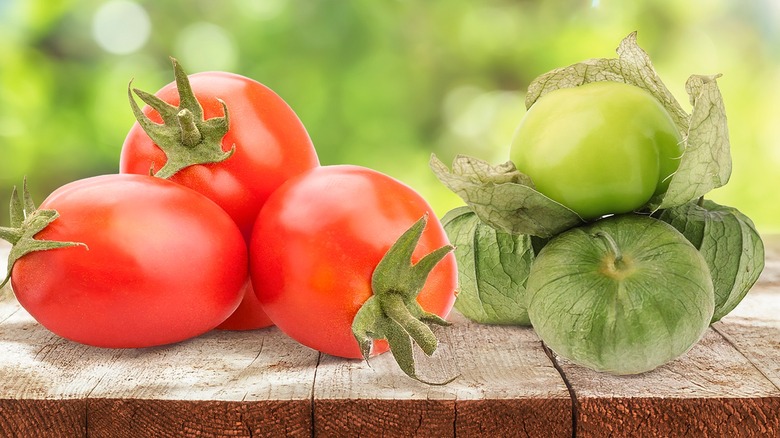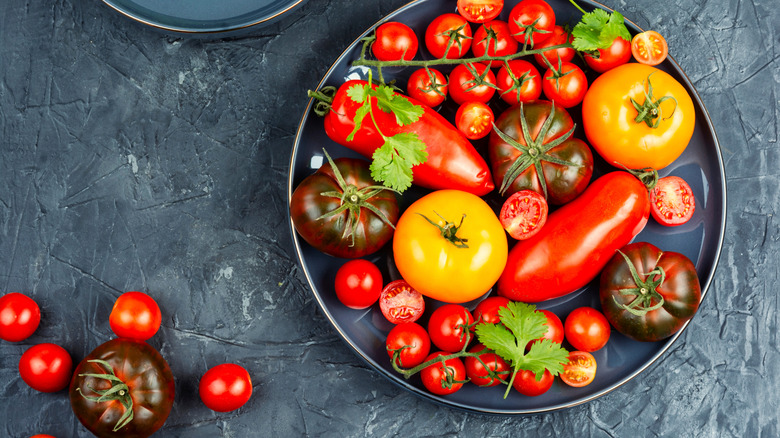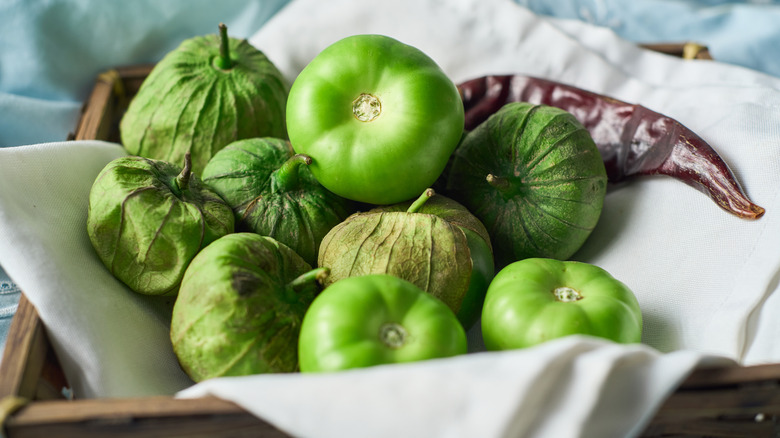You Really Should Learn The Differences Between Tomatoes And Tomatillos
Knowledge is recognizing that a tomato is a fruit, and wisdom is knowing not to put it in a fruit salad. But how far does your knowledge go when it comes to comparing tomatoes and tomatillos? Despite their similar-sounding names, these foods come from different plants and for the most part differ in appearance, taste, and the range of their culinary uses.
Modern tomatoes have much more variety, with a wide range of colors, shapes, and sizes. Each of these will have its own taste and texture. Tomatillos are smaller, firmer, and most often green (though sometimes purple or yellow) and grow with a papery husk.
The tangy taste of tomatillos can add brightness to a range of dishes, but traditionally you'll find them in Mexican or Central American cuisine. Tomatoes, on the other hand, have spread so far as to be a common ingredient in cuisines across most parts of the world.
What are tomatoes?
It's hard to imagine life without tomatoes. From pizzas and lasagna to BLTs or a comforting tomato soup, tomatoes show up in so many of our favorite dishes. But of course, this wasn't always the case. Tomatoes (along with peppers and potatoes) originated in the Americas and became known elsewhere after the arrival of the Spanish conquistadors.
With the spread and adoption of the tomato, many new varieties emerged that were selectively bred for size, taste, or ease of growing. While red is the most common color, you can also buy white, yellow, purple, green, and striped varieties. Tomatoes are one of the most versatile ingredients you'll find at your supermarket, that can be eaten raw, cooked, juiced, or dried.
Small, sweet cherry or grape tomatoes are ideal for snacking as part of veggie platter or adding bursts of flavor to a salad. Roma or plum tomatoes have a meaty texture and fewer seeds that make them ideal for canning and cooking, whether it's a fresh passata or a rich curry. Beefsteak tomatoes will give you the large firm slices needed for a sandwich or burger, while any of the heirloom tomatoes are the best choice for a caprese salad.
What are tomatillos?
Tomatillos belong to the same family as tomatoes (nightshades) but come from the Physalis philadelphica or Physalis ixocarpa plant. These plants are native to Mexico and Central America, and this is where you'll find tomatillos are still most commonly used.
Tomatillos grow with a unique husk, under which is a sticky residue that needs to be washed off before eating. Inside you'll find a small round fruit that remains green and firm even when ripe. While it might look like a green tomato, the two aren't usually interchangeable in recipes as they have quite different tastes and textures.
Unlike tomatoes, tomatillos don't come have the same scope of variety, which makes their use more limited. The tomatillo has a bright, tangy taste that makes it perfect for salsa, including one of its most common uses, salsa verde. The tartness can, however, enter overly acidic territory, so the fruits are often cooked to tone down the potency. Some traditional ways to cook tomatillos include making green enchiladas sauce, rich chile verde, and pozole verde- a tangy soup thickened with hominy. You don't have to stick to Mexican cuisine to enjoy tomatillos. Try this take on shakshuka with a tomatillo sauce, or tomatillo jam that balances sweet and savory for a versatile condiment.


